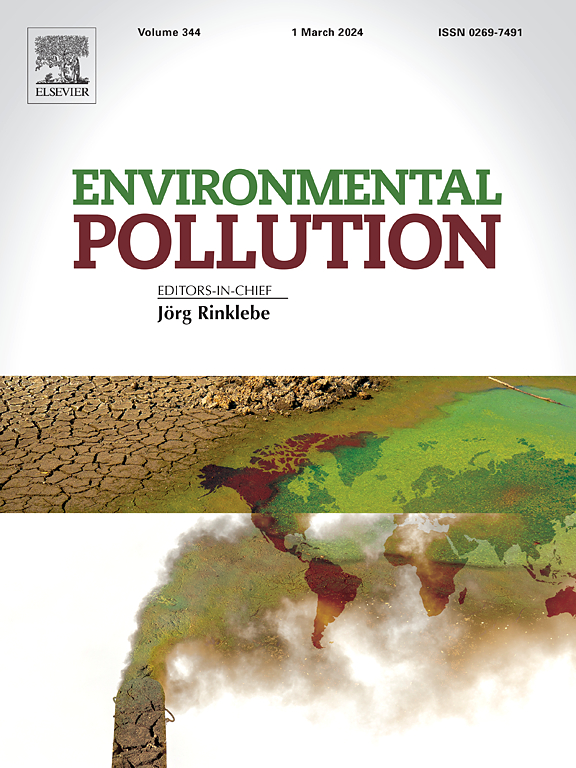Tracking antibiotics and antibiotic-resistant E. coli in the aquatic environment linked to agriculture
IF 7.6
2区 环境科学与生态学
Q1 ENVIRONMENTAL SCIENCES
引用次数: 0
Abstract
The application of manure to fertilize agricultural land is associated with the introduction of antibiotic residues and bacteria, including antibiotic-resistant bacteria, which can reach surface water through runoff and drainage and groundwater through leaching from the soil. This was investigated by sampling 50 surface water locations (before and after fertilization) and 50 groundwater wells for the presence of antibiotic residues and the presence of antibiotic-resistant bacteria. For the latter, Escherichia coli and extended-spectrum β-lactamase (ESBL) producing E. coli were used as indicators and profiled for antibiotic resistance. The presence of a wide range of antibiotic residues, though at low concentrations (0.01–10 μg/L), in freshwater ecosystems highlights the extensive spread of these substances. Only 16 % of the samples were consistently free of antibiotic residues throughout both sampling periods. Notably, the frequent occurrence of sulfonamides and lincomycin in surface waters raises concerns as their concentrations occasionally exceed the predicted no-effect levels for antimicrobial resistance selection. Maximum concentrations were reported at 8.83 μg/L and 1.60 μg/L for sulfamethoxazole and lincomycin, respectively. Additionally, resistance patterns in E. coli indicate increased resistance to sulfamethoxazole following the fertilization period, suggesting that the application of manure on fields contributes to a rise in antibiotic resistance from 20 % to 48 %. Although antibiotic contamination in groundwater is less prevalent, antibiotic resistance remains widespread. In particular, ESBL-producing E. coli exhibit heightened resistance levels, not limited to β-lactam antibiotics. The detection of resistance to critical last-resort antibiotics such as carbapenems and colistin further emphasizes the urgency of addressing antibiotic resistance in environmental contexts. This study highlights the need for continued monitoring and the implementation of legislation to reduce antibiotic pollution and tackle resistance in aquatic ecosystems.


追踪与农业相关的水生环境中的抗生素和耐抗生素大肠杆菌
施用粪肥给农田施肥与抗生素残留物和细菌(包括抗生素耐药细菌)的引入有关,这些细菌可以通过径流和排水到达地表水,通过土壤浸出到达地下水。通过对50个地表水地点(施肥前后)和50个地下水水井取样,调查抗生素残留和耐抗生素细菌的存在。对于后者,以大肠杆菌和产广谱β-内酰胺酶(ESBL)的大肠杆菌为指标,进行耐药性分析。淡水生态系统中存在多种抗生素残留,尽管浓度很低(0.01 - 10 μg/L),但突出了这些物质的广泛传播。在两个采样期间,只有16%的样本始终不含抗生素残留。值得注意的是,地表水中磺胺类药物和林可霉素的频繁出现引起了人们的关注,因为它们的浓度有时会超过预测的对抗菌素耐药性选择无影响的水平。磺胺甲恶唑和林可霉素的最高浓度分别为8.83和1.60 μg/L。此外,大肠杆菌的耐药模式表明,在施肥期后,大肠杆菌对磺胺甲恶唑的耐药性增加,这表明在田间施用粪肥导致抗生素耐药性从20%上升到48%。虽然地下水中的抗生素污染不那么普遍,但抗生素耐药性仍然普遍存在。特别是,产esbl的大肠杆菌表现出更高的耐药水平,不仅限于β-内酰胺类抗生素。对碳青霉烯类和粘菌素等关键最后手段抗生素的耐药性检测进一步强调了在环境背景下解决抗生素耐药性问题的紧迫性。这项研究强调需要继续监测和实施立法,以减少抗生素污染和解决水生生态系统中的耐药性问题。
本文章由计算机程序翻译,如有差异,请以英文原文为准。
求助全文
约1分钟内获得全文
求助全文
来源期刊

Environmental Pollution
环境科学-环境科学
CiteScore
16.00
自引率
6.70%
发文量
2082
审稿时长
2.9 months
期刊介绍:
Environmental Pollution is an international peer-reviewed journal that publishes high-quality research papers and review articles covering all aspects of environmental pollution and its impacts on ecosystems and human health.
Subject areas include, but are not limited to:
• Sources and occurrences of pollutants that are clearly defined and measured in environmental compartments, food and food-related items, and human bodies;
• Interlinks between contaminant exposure and biological, ecological, and human health effects, including those of climate change;
• Contaminants of emerging concerns (including but not limited to antibiotic resistant microorganisms or genes, microplastics/nanoplastics, electronic wastes, light, and noise) and/or their biological, ecological, or human health effects;
• Laboratory and field studies on the remediation/mitigation of environmental pollution via new techniques and with clear links to biological, ecological, or human health effects;
• Modeling of pollution processes, patterns, or trends that is of clear environmental and/or human health interest;
• New techniques that measure and examine environmental occurrences, transport, behavior, and effects of pollutants within the environment or the laboratory, provided that they can be clearly used to address problems within regional or global environmental compartments.
 求助内容:
求助内容: 应助结果提醒方式:
应助结果提醒方式:


